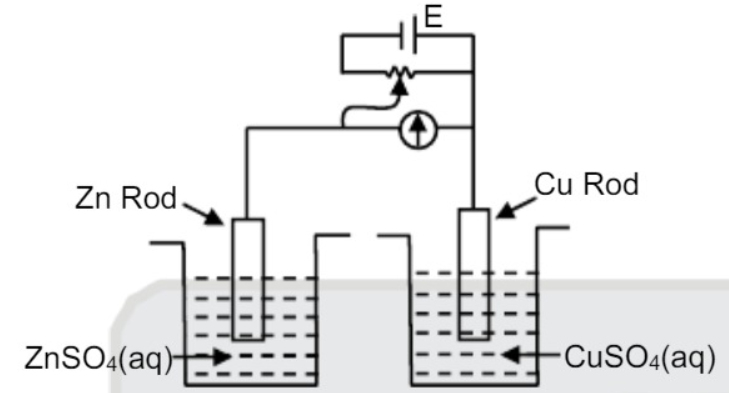A copper - silver cell is set up. The copper ion concentrations is 0.10 M. The concentration of silver ion is not known. The cell potential when measured was 0.422 V. Determine the concentration of silver ions in the cell.
Given E∘Ag+/Ag=+0.80V,E∘Cu2+/Cu=+0.34V
(a). A lead storage battery consists of a lead anode, a grid of lead packed with lead oxide (PbO2) as the cathode, and a 38% solution of sulphuric acid (H2SO4) as an electrolyte
When the battery is in use, the followig cell reaction take place
At anode: Pb(s)+SO2−4(aq)→PbSO4(s)+2e−
At cathode: PbO2(s)+SO2−4(aq)+4H−(aq)+2e−→PbSO4(s)+2H2O(l)
the overall cell reaction is given by
Pb(s)+PbO2(s)+2H2SO4(aq)→2PbSO4(s)+2H2O(l)
When a battery is charged, the reverse of all these reactions take place.
Hence, on charging PbSO4(s) present at the anode and cathode is converted into Pb(s) present at the anode and cathode is converted into Pb(s) and PbO2(s) respectively (b). The given cell is
Cu∣∣Cu2+(anode)∣∣Ag+∣Ag(s)(cathode))
the net reaction is
Cu(s)+2Ag2+(ag)→2Ag(s)+Cu2+(aq) ltbr> This involves transfer of 2 electrons Thus n=2
According to nearest equation<br>E_(cell)=E_(cell)^(0)+(0.059)/(2)log(([Cu][Ag^(+)]^(2))/([Cu^(2+)][Ag]^(2)))...(i)<br>[Ag]=[Cu]=1be∈gsol<br>Also,E_(Cell)=E_(Ag^(+)//Ag)^(0)-E_(Cu^(2+)//Cu)^(0)<br>=0.80-0.34<br>=0.46V<br>Substitut∈gthevalueofE_(cell)^(0)∈equation(i),we≥t<br>E_(cell)=0.46V+(0.059)/(2)log(([Ag^(+)]^(2))/([Cu^(2+)]))<br>0.422=0.46+(0.059)/(2)log(([Ag^(+)]^(2))/([0.10]))<br>orlog(([Ag^(+)])/(0.10))=0.0515<br>[Ag^(+)]^(2)=0.005<br>Ag^(+)=0.07M
Topper's Solved these Questions
- BOOK - RESONANCE ENGLISHCHAPTER - ELECTROCHEMISRYEXERCISE - Advanced Level Problems88videos
ELECTROCHEMISRY
- BOOK - RESONANCE ENGLISHCHAPTER - ELECTROCHEMISRYEXERCISE - Part 223videos
ELECTROCHEMISRY
- BOOK - RESONANCE ENGLISHCHAPTER - ELECTRO CHEMISTRYEXERCISE - PHYSICAL CHEMITRY (ELECTROCHEMISTRY)53videos
ELECTRO CHEMISTRY
- BOOK - RESONANCE ENGLISHCHAPTER - EQUIVALENT CONCEPT & TITRATIONSEXERCISE - Part -IV22videos
EQUIVALENT CONCEPT & TITRATIONS
Similar Questions
A copper-silver cell is set up. The copper ion concentration in it is 0.10 M. The concentration of silver ions is not known.The cell potential measured is 0.422 V. Determine the concentration of silver ions in the cell. [Given E∘Ag+/Ag=0.80,E∘Cu2+/Cu=+0.34V]
View SolutionThe standard electrode potential of Cu∣Cu+2 is - 0.34 Volt. At what concentration of Cu+2 ions, will this electrode potential be zero?
View SolutionIf excess ofZn is added to 1.0M solution of CuSO4 , find the concentration of Cu2+ ions at equilibrium.
Given:Ec−.(Zn2+∣Zn)=−0.76V
Ec−.cell=(Ec−.(Cu2+∣Cu)=0.34VView SolutionCalculate the emf of the given cell:
Cu/Cu2+(0.01M)∣∣Cu2+(0.001M)∣Cu is
(E∘Cu2+/Cu=+0.34V)View SolutionFor the reduction of silver ions with copper metal, the standard cell potential was found to be +0.46V at 25∘C. The value of standard Gibbs energy, ΔG∘ will be (F=96,500Cmol−1):
View SolutionOne half-cell in a voltaic cell is constructed from a silver wire dipped in silver nitrate solution of unknown concentration . Its other half-cell consists of a zinc electrode dipping in 1.0M solution of Zn(NO3)2 . A voltage of 1.48 V is measured for this cell . Use this information to calculate the concentration of silver nitrate solution used. (E∘Zn2+∣Zn=−0.76V,E∘Ag+∣Ag=+0.80V).
View SolutionConsider the cell Zn∣∣Zn2+∣∣∣∣Cu2+∣∣Cu. If the concentration of Zn and Cu ions are doubled, the emf of the cell.
View SolutionFor the given cell arrangement identify incorrect statement
given E∘_(Cu2+/Cu) = 0.34V &E∘_(Zn2+/Zn)=−0.76V View Solution
View SolutionFor the reduction of silver ions with copper metal, the standard cell potential was foound to be +0.46V at 25∘C. The value of standard Gibbs energy, ΔG∘ will be (F=96,500Cmol−1):
View SolutionCalculate the maximum work that can be obtained from the decimolar Daniell cell at 25∘C.
Given Ec−.(Zn2+∣Zn)=−0.76V and Ec−.(Cu2+∣Cu)=0.34VView Solution

